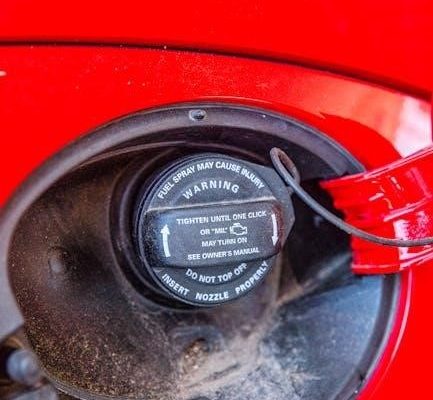Ender 3 Instructions: A Comprehensive Guide
Welcome to the ultimate guide for mastering the Creality Ender 3 series. This detailed resource covers setup, optimization, troubleshooting, and maintenance, ensuring flawless 3D printing experiences for all skill levels.
Whether you’re assembling an Ender 3 Pro, V2, or S1, this guide provides step-by-step instructions for calibration, firmware upgrades, and safety tips to maximize your printer’s performance and longevity.
1.1 Overview of the Ender 3 Series
The Creality Ender 3 series is a highly popular and cost-effective line of 3D printers, renowned for its reliability and versatility; Designed for both beginners and experienced users, it offers models like the Pro, V2, and S1, each tailored to different needs. Known for its ease of assembly, robust performance, and extensive community support, the Ender 3 series has become a top choice for hobbyists and professionals alike, delivering exceptional printing results at an affordable price.
1.2 Key Features and Benefits
The Ender 3 series excels with its open-frame design, large build volume, and quick assembly. It features resume printing, a self-adhesive build plate, and USB/SD card connectivity. Upgrades like silent stepper motors and direct drive extruders enhance performance. The printers are budget-friendly, highly customizable, and supported by a vast online community, making them ideal for both novices and enthusiasts seeking reliable, high-quality 3D printing experiences.

Setting Up Your Ender 3
Unbox, assemble, and configure your Ender 3 with ease. Follow detailed guides for a smooth setup, ensuring all components are properly aligned and calibrated for optimal performance.
2.1 Unboxing and Initial Assembly
Begin by carefully unboxing your Ender 3, ensuring all parts are accounted for. Follow the provided manual to assemble the frame, install the print head, and secure the filament holder. Tighten all screws firmly but avoid over-tightening. Attach the spool holder and ensure the extruder and bed are properly aligned. Double-check all connections and ensure the power cord is securely plugged into a three-hole power jack. Consult online guides if assembly feels complex or unclear.
2.2 Pre-Flight Checks and Safety Precautions
Before powering on your Ender 3, perform a thorough inspection. Ensure all screws are tightened and connections are secure. Select the correct input voltage (230V or 115V) to match your local mains. Plug the power cord into a three-hole power jack. Verify the print bed is level and the extruder is clear of obstructions. Double-check electrical connections to prevent short circuits. Always unplug the printer when performing maintenance and consult the manual or online guides if unsure about any step.

Software Setup and Configuration
Install Klipper firmware for enhanced performance and customize settings for optimal printing. Set up slicing software like Cura or Prusaslicer to prepare print files. Configure printer profiles and filament settings for precise results.
3.1 Installing and Configuring Klipper Firmware
Installing Klipper firmware on your Ender 3 enhances performance and customization. Download the latest version from trusted sources and follow step-by-step installation guides. Configure settings like printer dimensions, nozzle diameter, and filament type. Reboot the printer after flashing the firmware. Test print to ensure proper functionality. Adjust settings as needed for optimal results. Regular updates ensure compatibility and improved printing capabilities.
3.2 Setting Up Slicing Software (Cura, Prusaslicer, etc.)
Setting up slicing software like Cura or PrusaSlicer is crucial for preparing your 3D models. Install the software, add the Ender 3 printer profile, and select the correct nozzle diameter and filament type. Import your model, adjust settings like layer height and infill density, and slice the file. For beginners, start with default profiles and preview the G-code. Proper configuration ensures high-quality prints and optimal material usage.

Bed Leveling and Calibration
Bed leveling ensures proper first-layer adhesion. Adjust the bed screws, move the nozzle to each corner, and tighten until a paper barely fits. Repeat for accuracy.
4.1 Manual Bed Leveling: A Step-by-Step Guide
Preheat the printer to ensure the bed expands evenly. Move the nozzle to each corner using the control panel. Adjust the bed screws until a piece of paper fits snugly between the nozzle and bed. Tighten the screws gently to secure the bed. Repeat for all corners to achieve proper leveling. Ensure the bed is stable and even for consistent print quality.
4.2 Auto-Leveling Upgrades (BLTouch, CR Touch, etc.)
Auto-leveling upgrades like BLTouch or CR Touch simplify bed calibration. Install the sensor, connect it to the motherboard, and configure the firmware. These tools automatically adjust the bed, ensuring consistent leveling. Ideal for maintaining precise calibration over time. Follow detailed installation guides for specific models. These upgrades enhance print quality and reduce manual effort, making them a popular choice for Ender 3 users.

Upgrading and Optimizing Your Ender 3
Enhance your Ender 3’s performance with essential upgrades like a spring steel bed or direct drive system. These modifications improve print quality and durability. Install aftermarket parts carefully, following detailed guides to ensure compatibility and proper installation. Regular maintenance and firmware updates, such as Klipper, can further optimize your printer’s functionality and unlock advanced features. Upgrade wisely to elevate your 3D printing experience.
5.1 Essential Upgrades for Improved Performance
Upgrade your Ender 3 with a spring steel bed for better adhesion and durability. Install a direct drive extruder for smoother filament handling and reduced retraction issues. Adding a BLTouch or CR Touch enables auto-bed leveling, ensuring consistent first layers. Firmware upgrades like Klipper enhance speed and precision, while silent stepper motor upgrades reduce noise. These modifications significantly improve print quality, reliability, and overall performance, making them worthwhile investments for enthusiasts.
5.2 Installing Aftermarket Parts (Spring Steel Bed, Direct Drive, etc.)
Begin by removing the stock bed and attaching the spring steel bed using the provided screws. Adjust the bed springs for proper tension and ensure the bed is level. For a direct drive extruder, remove the stock extruder, install the new mount, and connect the motor and tubing. Tighten all connections securely and test the setup with a calibration print. These upgrades enhance functionality and print quality, offering a smoother 3D printing experience.

Maintenance and Troubleshooting
Regularly clean the print head, check belt tension, and lubricate axes. For issues, adjust bed leveling, ensure proper filament flow, and clear clogs promptly to maintain optimal performance.
6.1 Routine Maintenance Tasks
Perform regular maintenance to ensure optimal performance. Clean the print head and nozzle, check belt tension, and lubricate linear rails. Inspect and tighten all bolts, especially after initial assembly. Update firmware periodically and ensure proper filament flow. Regularly check and clean the PTFE tube and extruder gears. Maintain a clean build plate and ensure bed leveling is accurate. Replace worn-out parts like the ABL sensor or fans as needed. Schedule these tasks to prevent print failures and extend the printer’s lifespan.
6.2 Common Issues and Solutions
Address common issues promptly to ensure smooth printing. Bed leveling problems can cause uneven prints; re-level the bed and check springs. Filament jams often occur due to incorrect temperature settings or debris in the extruder. Clean the extruder and adjust temperatures. If the print doesn’t stick, ensure the first layer height is correct. For noise, tighten belts or replace worn pulleys. Addressing these issues early prevents failed prints and extends the printer’s efficiency and lifespan.

Advanced Configurations
Explore custom firmware settings, print quality optimizations, and advanced upgrades like Direct Drive. Fine-tune your Ender 3 for superior performance and precision in every print job.
7.1 Fine-Tuning Your Printer for Optimal Prints
Refine your Ender 3’s performance by adjusting retraction settings, Z-offset, and belt tension. Experiment with print speeds and temperatures to achieve flawless layer adhesion and surface finish. Utilize test prints like calibration cubes or benchy boats to evaluate changes. Implementing these tweaks ensures consistent, high-quality results tailored to your specific printing needs and filament types.
7.2 Customizing Firmware Settings
Enhance your Ender 3’s performance by customizing firmware settings. Install Klipper or other advanced firmwares to unlock features like pressure advance and mesh bed leveling. Adjust parameters such as acceleration, jerk, and retraction settings to optimize print quality and speed. Use tools like OctoPrint or Fluidd to monitor and fine-tune settings remotely. Regularly update firmware to access new features and improvements, ensuring your printer stays optimized for various filaments and print configurations.

Safety Guidelines
Ensure safe operation by selecting the correct voltage, securing power connections, and preventing overheating. Always follow assembly and usage guidelines to avoid potential hazards.
8.1 General Safety Tips
Always select the correct input voltage (230V or 115V) to match your local mains. Ensure the power cord is securely plugged into a three-hole power jack to prevent electrical hazards; Avoid overheating by maintaining proper airflow and checking temperature settings. Keep flammable materials away from the printer and never leave it unattended during operation. Follow all assembly and usage guidelines to minimize risks and ensure safe printing experiences.
8.2 Emergency Procedures
In case of emergencies, immediately turn off the printer and unplug the power cord. If a fire occurs, use a fire extinguisher rated for electrical fires. For power supply issues, disconnect the unit and let it cool. Always handle hot components with care. Keep a fire extinguisher nearby and ensure good ventilation in the workspace. Regular maintenance can prevent many potential hazards.

Resources and Support
Access official manuals, firmware updates, and slicing software on Creality’s website. Join forums like Reddit and Facebook groups for troubleshooting and tips from the Ender 3 community.
9.1 Official Documentation and Manuals
Creality provides comprehensive official documentation for the Ender 3 series, including detailed assembly guides, troubleshooting tips, and maintenance schedules. These resources are available on their website and often include video tutorials. Additionally, the USB flash drive accompanying the printer contains essential manuals and firmware updates to ensure smooth operation. Regularly updating your printer’s firmware can enhance performance and compatibility with modern slicing software.
9.2 Community Forums and Support Groups
The Ender 3 community is vast and active, offering extensive support through forums, social media groups, and specialized platforms. Resources like Reddit’s r/ender3, Facebook groups, and Discord servers provide invaluable tips, troubleshooting, and modifications. These communities are perfect for sharing knowledge, asking questions, and staying updated on the latest trends in 3D printing. Engaging with these groups can significantly enhance your printing experience and help you overcome challenges efficiently.
Mastering the Ender 3 requires patience and practice. This guide has covered essential setup, optimization, and troubleshooting steps. With consistent effort and community support, you’ll achieve exceptional printing results and unlock endless creative possibilities.
10.1 Final Tips and Next Steps
Continuously explore new techniques and experiment with settings to refine your printing skills. Join online forums for community support and stay updated on the latest upgrades. Regularly maintain your printer to ensure optimal performance. Expand your projects by exploring advanced features like dual extruders or multi-material printing. With dedication and practice, you’ll unlock the full potential of your Ender 3 and create stunning 3D prints consistently;
